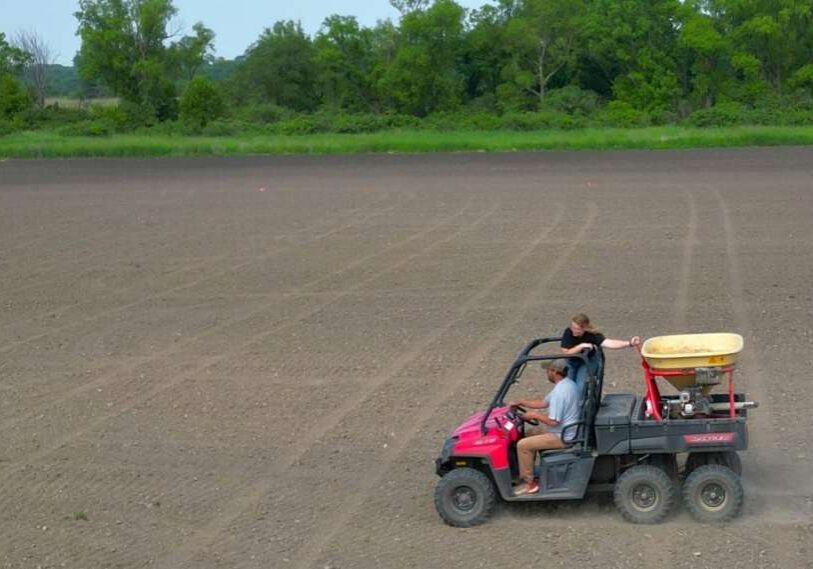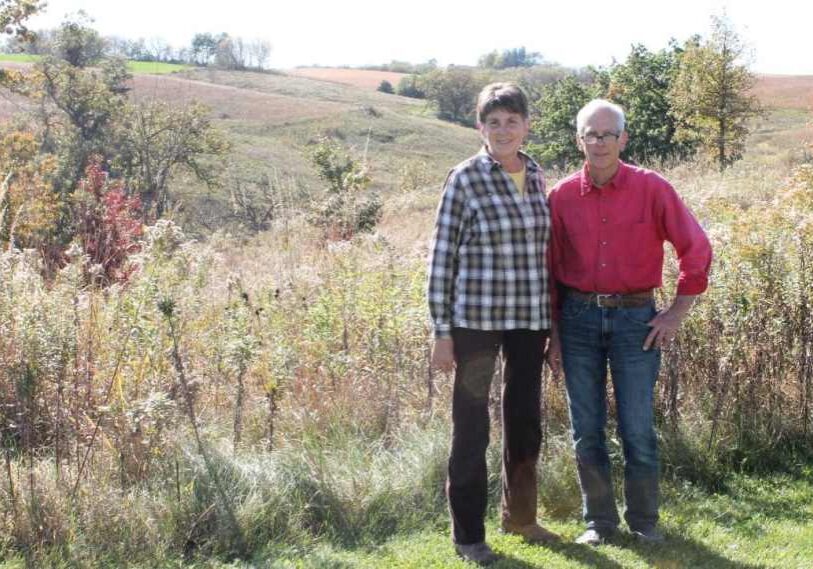Wild Rice Returns to Nearby Stretches of Mississippi River
Wild Rice is booming on the Upper Mississippi River–Arrowhead tubers and American lotus aren’t the only stands of aquatic vegetation expanding through the river.

MISSISSIPPI RIVER VALLEY — If she closes her eyes, Danelle Larson can still remember how the stretch of Mississippi River in front of her looked as recent as a decade ago: nothing but open, muddy water.
Today, it’s covered with impressively tall and thick beds of wild rice.
Larson, a research ecologist with the U.S. Geological Survey, and Alicia Carhart, Mississippi River vegetation specialist for the Wisconsin Department of Natural Resources, surveyed the plants by airboat this past fall. Summer floods on the river delayed growth somewhat, but the tall green shoots still waved in the breeze in almost every direction off the shores of Wisconsin’s Goose Island County Park on the east side of the river opposite Houston County, Minn.
“It’s one of the most dramatic changes on the upper Mississippi,” Larson said. “It’s everywhere.”
In the past several years, wild rice has exploded on this part of the upper river, particularly on this section called Pool 8, between Houston County and La Crosse, Wis., and further north in Pool 4, near Alma, Wis.
Historical records show it was common in the late 19th and early 20th centuries, but poor water quality and other problems caused widespread aquatic vegetation die-offs in the 1980s.

A 1939 photo of wild rice on Blue Lake in La Crescent, Minn., adjacent to the Mississippi River. (Photo courtesy of the Upper Mississippi River National Fish and Wildlife Refuge)
For some, the resurgence is a source of wonder. For others, it’s more of a nuisance, making it hard to maneuver boats through areas that were once easily passable.
But what’s driving the substantial increase in growth is still largely a mystery.
Wild rice is expanding
Wild rice is an annual plant, meaning it completes its entire life cycle in one growing season and then dies.The seeds germinate in spring, then sprout to lie flat on the water like ribbons during their floating-leaf stage.
During the summer months, the plants emerge from the water, and new seeds ripen and drop into the river in early fall to start the process over again.
Places now known as Minnesota and Wisconsin have rich histories of wild rice harvesting dating back thousands of years with the Menominee, the original people who were named “People of the Wild Rice.” Wild rice, or manoomin, is also closely associated with Ojibwe tribes that arrived hundreds of years ago in search of “food that grows on water.”
Today, it’s still a central part of tribal diets and identity, but it’s facing serious threats from climate change, fluctuating water levels and human interference. In 2024,for example, storms and heavy rains in June negatively impacted wild rice production across northern Wisconsin.
The rice growing on the upper Mississippi is different. It can reach about 12 feet tall, while plants in northern lakes are typically waist-high — far easier to shake into a boat to harvest, Larson said.
And it appears to be more resilient to water fluctuations. Carhart said everything she’s read about wild rice would indicate it’s extremely sensitive, but much of it survived the high water earlier last summer — and in previous years, when the river was in drought, it was more prevalent than she’d ever seen.
“That’s what’s maybe most confusing,” she said. “The rice just seems to be doing well regardless.”

Alicia Carhart, Mississippi River vegetation specialist for the Wisconsin Department of Natural Resources, peers into a tall wild rice bed on the river in the summer of 2023. Credit: Alicia Carhart, Wisconsin DNR
In 2024, wild rice was identified at 30 percent of the DNR’s 450 regular sampling sites on the river near La Crosse, Carhart said.
Data from a wide-ranging 2022 report on the upper river’s ecological status and trends backs this up — prevalence of wild rice in pools 8 and 4 increased by “an order of magnitude” in the past decade, the report’s authors wrote, covering thousands of hectares.
The greatest changes have occurred in places where rice has moved into deeper waters, Carhart said. Previously, wild rice was most commonly found in the still, shallow backwater areas of the river. Now, it’s thriving just as much in the river’s main channel, where the water moves quicker and is disturbed more regularly by boats and wind.
The rice appears to be “marching downstream,” Larson said, appearing sporadically on the river down to the river’s border with Illinois. It has not yet been identified farther south on the Iowa-Illinois border.
Water quality is improving
The 2022 report noted that aquatic vegetation in general is thriving on the upper Mississippi between Wisconsin and Minnesota, and water clarity has improved.
Such an improvement may be making it easier for wild rice to establish, but the fact that it’s surging in some places and not others means there’s probably more to the story, Carhart said.
Others think it may be linked to sediment building up in the backwaters, making them shallower and more amenable to the wild rice plant.
Larson said she hopes to do more research about the rice’s habitat preferences to learn more about why it’s increasing in some areas and not others.
She also wants to know more about what kinds of animals use the wild rice and for what purpose. It’s an important food source for ducks, for example, and marsh birds like to hide in the dead stalks as the weather turns colder.
Upper Mississippi is changing
Not everyone is thrilled with the rice’s expansion — particularly those who’ve watched the water they used for recreation turn into a giant rice bed. Lake Onalaska, a large reservoir of the river, is one such place.
In the 1980s, there were a few stands of wild rice on the lake, said Marc Schultz, chairman of the Lake Onalaska Protection and Rehabilitation District. It started expanding about a decade ago, “almost with a vengeance,” he described.

A wild rice plant is pictured on the upper Mississippi River. It is taller than native wild rice in northern Minnesota. (Photo by Madeline Heim, Milwaukee Journal Sentinel)
The rapid change even triggered now-dispelled rumors that people were intentionally planting wild rice in the lake.
The problem is that Lake Onalaska is a major draw in the region for fishing and boating. Despite having established “boat channels,” the rice just keeps growing, Schultz said, making it difficult for boaters to get from one side of the lake to the other — or even from their dock to the boat channel itself. And while the lake district can pay to clear it, that’s costly.
Schultz said he’s long viewed wild rice as a valuable resource. But he sympathizes with people who have seen changes to the river accelerate in recent years because of climate change and land use changes.
“They look at rice and say, ‘That’s just another one of those things that’s changing everything,'” he said. “You can understand why people have a lot of concerns.”
Last summer’s flood cut back some wild rice growth on Lake Onalaska, but Carhart said she met with the group to hear out their worries.
She asked them to consider what the lake might look like if it was all gone — the water would be more turbid, for example, and fish that like clearer water could be driven away.
Larson recalled what the river used to look like when she was a kid: muddy and not safe to swim in.
“Now, it’s pretty crystal clear,” she said. “The plants seem to love it too.”

This story is from the Mississippi River Basin Ag & Water Desk, an editorially independent reporting network based at the University of Missouri School of Journalism, in partnership with Report For America and the Society of Environmental Journalists with funding provided, in part, by the Walton Family Foundation.
Contributor
Madeline Heim, Mississippi River Basin Ag & Water Desk
Madeline Heim reports for the Milwaukee Journal Sentinel and the Mississippi River Basin Ag & Water Desk. She has interned at the Wisconsin Center for Investigative Journalism and reported for the Winona Daily News.






